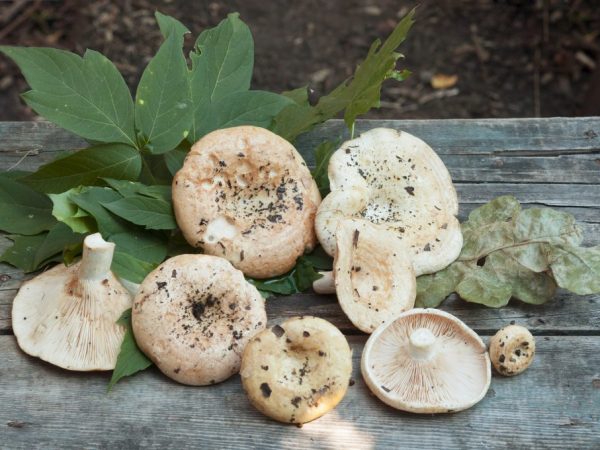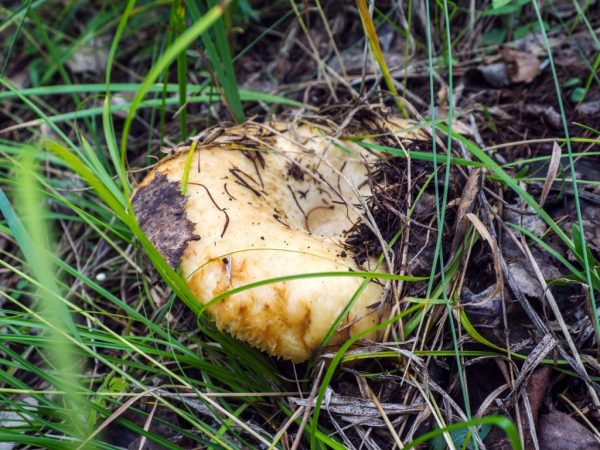Features of the weight of yellow
A mushroom called yellow milk mushroom is a species that grows in certain climatic conditions, mainly in coniferous forests. It differs from other representatives of the fungal community in the size and single (or small groups) growth of fruit bodies.

Features of the weight of yellow
The appearance of the mushroom
A yellow lump, or as it is also called a yellow wave, or podskrebysh, grows up to 8-11 cm in height. According to the species description, the mushroom has a yellow cap and a milky leg. Under the cap is the fleshy part, which is golden yellow in color. This distinguishes the mushroom from the inedible species, in which the place is dark. The hymenophore is lamellar. The leg of an adult mushroom reaches a diameter of 1 cm.
Irina Selyutina (Biologist):
As with other mushrooms, the scraper is characterized by a change in the shape of the edges of the cap as it grows: at first, they are slightly bent, they gradually spread out. The skin can be slimy (sticky), smooth or even "woolly" with present, albeit not very noticeable, concentric zones. The white pulp is characterized by a fairly high density and at the same time - fragility, fruity aroma and discoloration on the cut (turns yellow). Thick and white milky juice turns grayish-yellow on contact with air. The plates of the hymenophore are frequent, they descend slightly along the pedicle, which is clearly visible. Initially light, they become covered with reddish-brown spots with age. The leg, like the cap, is sticky, inside it is hollow.
The fruit body has a pungent odor that disappears after heat treatment. There is a film on the head of the plant, which is removed before cooking, because it has a bitter and tart taste.
Milk yellow forms mycorrhiza with representatives of conifers and birches.
Beneficial features
The yellow milk contains enough vitamins and minerals to enrich the body with them after ingestion of this product. It cleans the intestines from harmful perennial accumulations of formations located on its walls.
Yellow milk mushrooms contain a lot of protein, which contributes to their replacement of meat products in the diet. Also, during diets and weight loss, this product is used because of the small amount of calories (12-16 kcal per 100 g) and high fiber content. It removes all harmful substances from the body, cleanses the blood and skin.
Contraindications
Despite the presence of useful qualities and a list of contraindications, the use of a yellow mushroom mushroom has a list of contraindications:
- high blood pressure (hypertension, or hypertension);
- liver disease;
- diseases of the gastrointestinal tract.
The last point implies inflammation and diseases of the stomach: ulcers, gastritis. For problems with the intestines, the product is useful. According to experts, the use of milk mushrooms has a positive effect on the body and the human digestive system as a whole.
It is worth using this mushroom with caution during pregnancy and during breastfeeding: during these periods, the woman's body reacts unpredictably to certain foods.Before using them, it is worth visiting a specialist.
It is forbidden to use yellow milk mushrooms for children under 12 years of age and the elderly: their body lacks enzymes for proper assimilation of the product.
Application

Mushrooms are important to cook properly
The yellow milk mushroom is used during cooking in different variations:
- frying;
- extinguishing;
- pickling;
- salting;
- canning;
- cooking.
When cooking, it is imperative to strictly follow the recipes: incorrect proportions and, accordingly, the same cooking can cause poisoning of the human body.
Also, yellow milk mushrooms are used during the manufacture of medicines. They have an antiseptic and absorbent effect. Before use, consultation with a specialist is necessary due to the presence of a number of contraindications.
In cooking
There are many recipes that use this product. Be sure to take into account the compatibility of the components of the dish, otherwise the milk mushrooms will not be properly assimilated, which threatens with poisoning.
Irina Selyutina (Biologist):
Before using the yellow wave, it needs preliminary processing - soaking. This will get rid of the unpleasant bitter taste that milky juice imparts to the mushroom. To do this, the harvested crop is soaked for several days in cold water, changing it at least 2 times a day. Earlier, and even now, in places with a favorable ecological situation, waves (and other milk mushrooms) are soaked by placing them in a bag and sending it into the waters of the river. To save time, instead of soaking, you can boil the waves for 30 minutes or a little more, and then drain the water and rinse the mushrooms thoroughly under running water. But, according to lovers of milk mushrooms, "the game is not worth the candle" - the taste of the product, in their opinion, does not change for the better. Plus - it is also a deviation from the classic technology of preparing milk mushrooms.
In salted form, the yellow milk takes on a yellowish-brown color with a characteristic gray tint, and its flesh becomes greenish.
According to the culinary rules for processing and cooking, it is permissible to combine them with other types of mushrooms, if you take into account the correct proportions and method of processing all the products that are included in the dish. The mushroom belongs to category 1.
In medicine
In medicine, this type of agaric fungi is used in the manufacture of antiseptic and absorbent preparations.
Currently, it is difficult to find medicines with this mushroom in the composition. There are several products that equally replace its properties, but they are all of a chemical origin.
You should not self-medicate and cleanse the body with this product uncontrollably: incorrect dosage and proportions will lead to poisoning.
Growing methods
It is possible to grow the fruiting bodies of a mushroom of the type yellow milk mushroom only on the territory of a coniferous forest. The climate should be moderate with high humidity. It is impossible to grow this product under greenhouse conditions: it needs sunlight and natural precipitation - they saturate it with all the components necessary for normal growth.
There should be old stumps next to the mushroom. The products of their natural decomposition are fertilizers for fruit bodies. Without their participation, mushrooms will not be able to receive all the necessary substances and will die before reaching the age necessary for harvesting.
Conclusion
The yellow milk mushroom is used for food, since it has useful vitamins and minerals. To grow it, the correct climatic conditions and an area with coniferous trees are required.
Be sure to take into account the contraindications while using this product. Pregnant women and during breastfeeding should eat mushrooms after consulting a specialist.



